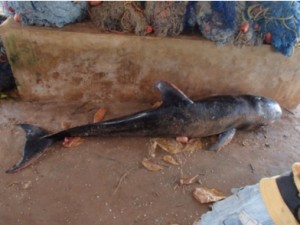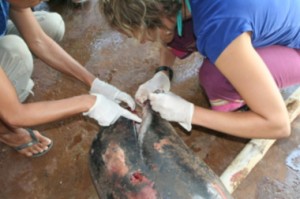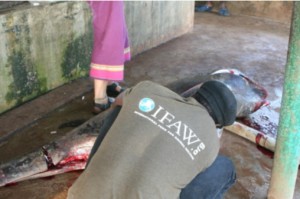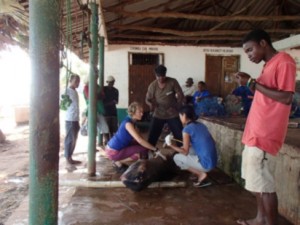Zanzibar Humpback Whale Research Project 2012
Blog 7: Risso’s Dolphin Necropsy 21/07/2012
Saturday the 21st of July was the start of Ramadhan in Zanzibar which, coupled with a rough sea, resulted in the project team enjoying a quiet day off. We used this precious down-time to get some computer based project work done and to do some washing. After a fairly relaxing morning, the team received a call from Pandu (one of our local contacts) who informed us a by-caught dolphin had been landed in our neighbouring village, Kizimkazi-Mkunguni. After quick preparations to bring the necropsy kit and data forms together we were driven straight to Mkunguni to take photos and collect samples from the dolphin.
The “dolphin” found by fishermen from Kizimkazi-Mkunguni
However, when we arrived, to our surprise we discovered it wasn’t a bottlenose or humpback dolphin but a species we don’t normally see in the waters around southern Zanzibar. We were relieved when we found out the fishers found it dead and floating in the water meaning it was not another by-caught dolphin. At first glance, Kyla thought it might be a pygmy killer whale (Feresa attenuata) or melon-headed whale (Peponocephala electra) based on the body size, shape and colouration but we were baffled as some features, such as the very tall dorsal fin and the teeth (or lack thereof!) didn’t seem right. Of course, after sending photos to the project leader Dr Per Berggrenat Newcastle, he suggested it might be a Risso’s dolphin calf; Risso’s dolphins (Grampus griseus) are very scratched resulting in a greyish colouration but a calf/juvenile is still quite dark and Risso’s dolphins have very few teeth.
Kristin and Kyla looking for the teeth…and only finding two tiny ones at the front!
As soon as we arrived at the fish market at the beach in Mkunguni we started taking photos, measurements and collected tissue samples of the dolphin. As mentioned above, no teeth could be seen initially; we thought it might be an older animal with very worn teeth, but on close inspection we found two very small teeth at the front of the jaw. So, a section of the jaw bone with the two teeth was removed as a sample. The cause of death was not identifiable as there were no external signs such as lacerations, or injury from fishing gear, however, the animal looked under nourished. We were not able to conduct a complete necropsy on the animal but we collected the stomach contents for possible dietary analyses.
Yunusu, a friend of the project, helping us collect samples
Members of the research team checking out the Risso’s calf with fishers from Mkunguni watching with curiosity.
One thing we didn’t think about when we collected the bucket of guts to take back with us was the smell we’d have to endure on the drive back to Kizimkazi-Dimbani! We ended up driving the entire way with back of the car open, much to the amusement of all the locals. All in all, it was a very unexpected but interesting day!
Photographs © Zanzibar Humpback whale Project




